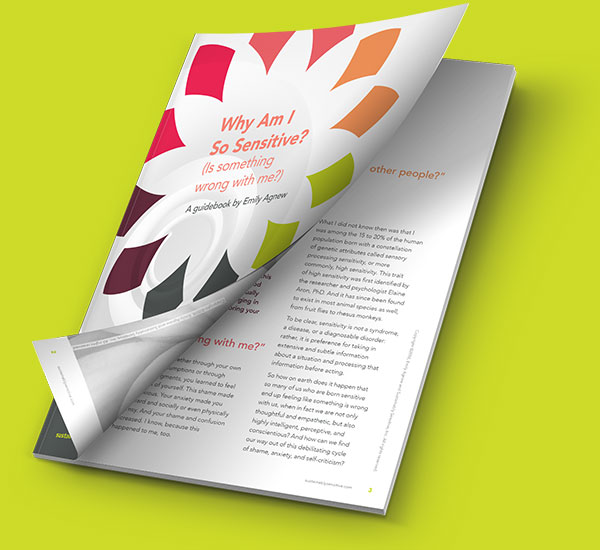To create a sustainable life as an HSP, you need strong intent. Intent empowers you to take action guided by your spiritual intuition, rather than by old habits and fears.
Writing in my journal the other day, I found myself playing with the word “sacred.” I let the “a” stand for awareness, and the “c” stand for choices. That made sense to me: sacred action happens when I put awareness first, then choose how to act.
Then I flipped the “a” and the “c.” “Sacred” turned into “scared.” This made sense to me, too. When I act before becoming aware, I do get scared. I go downhill from there, too, because when I’m scared, my awareness contracts even more.
This sounds abstract. It’s not. I make choices all day. What motivates these choices? Who makes them? Is it me—the “bigger me” that can connect to my spiritual intuition? Or is it a part of me?
If a part of me is making the choice, then by default it will act from fear, attempting to exert control over people and situations. That’s what parts do. They don’t have the bigger picture, and they can’t access your spiritual intuition, so naturally they are scared.
As I’ve learned from Inner Bonding, my default stance is to try to control everything. This isn’t unique to me: we all do it…unless we choose to open to learn. That’s the essence of the spiritual path: to choose the intent to learn, moment by moment.
Do I want to focus on protecting myself from pain? Or do I want to open to learn from what is happening moment by moment, so I can take responsibility for myself and grow to become kinder, stronger, and more loving? It’s my choice, and yours. That’s the definition of free will.
Setting your intent = choosing your course
Opening to your spiritual source as a guide to action isn’t a one-off proposition. You have to choose again and again. In the crush of everyday life, it’s easy to miss those moments of choice, or to forget how important they are.
Only by setting a strong intent, reaffirmed every day, do you have a chance of remembering and acting on this sacred choice. Like Captain Kirk of the starship Enterprise, you have to set your course. He might say, “Mr. Sulu, set a course for Alpha Centauri.” You, on the other hand, will say things like, “I intend to pause today before responding to requests for help.”
To be clear, your intent doesn’t exist in a vacuum. The rhythm and order of your life (or lack of it), the company you keep, the way you care for your body—all these affect your ability to be clear enough to set your intent and to follow through on it.
7 insights to strengthen your intent
What strengthens your intent? Here are seven points clarifying the architecture of intent, and laying out what you need to do to develop strong intentionality.
Notice that the first two items comprise an infinite loop. In fact, these seven items appear by necessity as a sequential list, but in reality, they are like a web, each affecting all the others.
1—To return to the sacred, you need to exercise awareness
Our default stance is to try to control everything. This is primitive, from our early evolution. For that reason, awareness is the essential precursor to setting your intent: in order to choose the intent of openness and spiritual connection, you have to be aware you are facing a choice in the first place.
From this place of awareness, you can set your intent. Then you can make choices from your highest values, show up as your best self, and take actions that help you express your best self fully in the world.
2—To heighten your awareness, you need a clear intent.
Setting your intent heightens your awareness. For example, if you set your intent to have patient, peaceful interactions with someone you struggle with, you will notice and appreciate any instances of patience and peace. You will also notice more clearly what you did that was (or wasn’t) helpful, so you can build on that knowledge.
In other words, awareness and intent comprise an infinite loop. The more aware you are, the easier it is to set your intent. The stronger your intent, the more aware you become of what actions are and aren’t in harmony with your intent.
3—To set your intent effectively, you need to be calm and present.
You can’t set a powerful intent when you are overwhelmed, scattered or distracted. Consider the synonyms of “intent:” Determined. Resolute. Absorbed. Firm. Committed. Engaged. Engrossed.
In short, intent is not wishy-washy. To will something feels completely different from merely wishing it. It’s the difference between saying, “I wish I could find a job that works better for me, and, “I will find a job that works better for me.”
Intent requires focus, calm, and presence. You have to marshal it, and set it the way you set the wick of a lamp, so it burns pure and bright.
4—To be calm and present, you need practices for self-regulation and meditation practice for spiritual connection.
It’s that simple. For highly sensitive people, self-regulation requires some kind of daily practice. I strongly recommend a coherent breathing practice along with some form of meditation—specifically, one that goes beyond calming the mind to include a conscious intent to connect with your spiritual essence.
I also recommend you explore these six strategies for creating a morning routine to help you connect to Spirit. Learn about how to recognize and trust your spiritual intuition. And know what to do when you are having trouble hearing your spiritual intuition.
5—To reliably practice self-regulation and meditation, you need a sturdy, consistent personal infrastructure
By “personal infrastructure,” I mean habits, routines, and structures that support a sustainable sensitive life. This article describes what sturdy personal infrastructure looks like for a highly sensitive person, and how to use the principles of frequency, duration, and intensity to adjust your self-care routines when you are under unusual stress.
I also highly recommend these practical resources, which will—
- Strengthen your routines
- Help you discern which of your tasks and obligations are important, and which are merely urgent
- Help you set up an airtight organizational system
- Support you in defining your responsibilities so you don’t take on too much in the first place.
6—To create and maintain a sturdy, consistent personal infrastructure, you need a healthy inner relationship
Your personal infrastructure will always be a work in progress, adjusting to your needs and to the conditions of your life. To engage in this ongoing work will require a non-judgmental stance towards yourself, and a willingness to be patient, experimenting over time to find out what works and what doesn’t work.
To be nonjudgmental and patient with yourself, you need a healthy inner relationship. To nurture this inner relationship, try this seven-step Focusing-oriented process to restore inner peace when you get triggered. You can also use it to celebrate and savor good feelings, or to clear the air before bed.
In the end, you can’t separate your inner relationship from all the other items on this list. It affects, and is affected by, your personal infrastructure, your ability to self-regulate, your spiritual connection, your spiritual practice, and your intent…like a web.
7—To nurture a healthy inner relationship, you may need support to develop new skills and awareness and to experience a new way of being.
HSPs have several reasons for seeking one-to-one support. You may be experiencing temporary situational overwhelm. Or, at the other end of the continuum, you may be sturdy and happy, and you simply want to go deeper, exploring the playground of your inner world.
For many HSPs, though, one-to-one work is a way to cultivate a better inner relationship—to overcome chronic shame, self-doubt, and anxiety. Working one-to-one, you can leverage your environmental susceptibility in a positive way.
It’s well known that HSPs are affected more by negative relational environments: that’s likely where you developed shame and anxiety in the first place. Fortunately, the opposite is also true. In a nurturing, safe relationships—both professional and personal— you can begin to create a better inner relationship. Because your inner world is always with you, changing it transforms your experience of life.
Circling back to your intent
As we’ve seen, these skills, structures, and practices form a web. Each strengthens or weakens the others by its own strength or weakness. Without good self-care, healthy routines, and a positive inner relationship, you will find it far more difficult to achieve the critical mass of intentionality you need to look at painful beliefs, change long-standing habits, and heal old pain and trauma.
However, you have to start somewhere…and your intent is the single most important element in the change process. Whatever shape you are in, whatever your circumstances, there will come a point where you have to make up your mind that you can make changes, that you want to make changes, and that you will make changes.
Then, even if you have no idea how to go about it, you can humbly ask the powers that be for help. Prayer—by which I simply mean saying, “Help!” to whoever might be out there listening—is the bridge between you and achieving what may appear impossible from your current vantage point.
In other words, it’s fine to be clueless. You don’t have to know how to get from Point A to Point B. In fact, believing you have to know what to do next is one of the biggest blocks to forward motion. You just have to cultivate a strong, clear intent and be willing to ask for help. This is your key to create a sustainable life as an HSP.
Photo ©2022 Emily Agnew



















